Rail travel in the United States
overview of rail transport in the United States of America
The United States may be the land of the car, but it is also a fantastic country to explore by passenger train. Private operators offer exclusive and luxurious packages on trains, but it is on board the trains of the state-owned and subsidized Amtrak that most tourists and travelers experience America by rail. The coast-to-coast journey from San Francisco to New York City by train is one of the world's great rail journeys, and is known for its breathtaking scenery and historical significance.
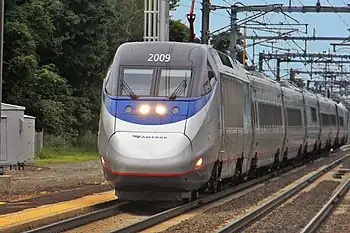
Understand
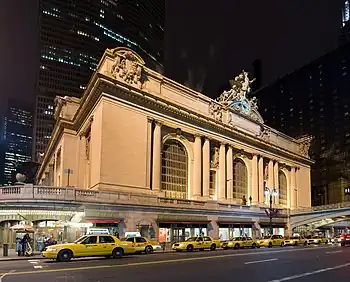
Amtrak, the quasi-government-owned passenger rail company, is the only operator of regularly scheduled long distance passenger trains in the contiguous United States. With the exception of the Amtrak-owned-and-maintained Northeast Corridor (between Boston, New York City, Philadelphia, Baltimore, and Washington, D.C.), as well as some services in Pennsylvania, California, and around Chicago, Amtrak services are substantially slower, less reliable, and less frequent than those of virtually every other developed nation in the world. With no true high-speed lines (and a general speed limit of 79 mph (127 km/h)), trains in the U.S. often take longer than cars or planes, and are often more expensive than flying when travelling between major cities (though minor towns can be vastly cheaper to reach on Amtrak than by plane).
Despite all this, the unique experience can trump the often high cost and long ride. Trains remain popular with many travelers because of the social atmosphere on board, the lighter environmental impact compared to planes, the spacious design of the cars, the scenic routes, and the overall comfort of the ride. A trip from one coast of the U.S. to the other is surely one of the greatest railway journeys that you can make anywhere in the world, and with the different classes of on-board accommodation and a variety of tickets and passes available, it can also be remarkably affordable.
The largest cities in the United States with no single railroad station (either Amtrak, a commuter railroad or a heritage railroad) in service are Phoenix (light rail present), Columbus and Las Vegas (a short monorail line exists).
Higher-speed rail in the U.S.
The closest thing the U.S. has to a high-speed rail line is Amtrak's Acela, which runs between Boston and Washington, D.C. via New York City. Although Acela trains themselves are capable of attaining very high speeds, the route does not run on any dedicated high-speed tracks like high-speed trains in Europe and East Asia do, so they are limited to relatively low speeds for most of the journey. For this reason, expect journey times on Acela to be only marginally faster than taking the regular Northeast Corridor trains, which stop more often and have a lower top speed but cost significantly less. While plans have been mounted to build dedicated high-speed rail lines in various parts of the country, strong conservative political opposition and successful lobbying by airlines and car manufacturers have repeatedly scuttled these attempts.
History
Before 1971: The golden era
The United States was one of the pioneers of rail travel. In the days before flying, rail transport was the main way to travel long distance, and played an instrumental role in the colonization of the Wild West in the late 19th century. Perhaps the most significant event in the history of American railroads was the driving of the final spike at Promontory, Utah in 1869, which marked the completion of the First Transcontinental Railroad between New York City and San Francisco. The advent of rail transport also played a key role in the industrialization of the United States, as it allowed raw materials and goods to be transported rapidly across the country, and allowed people to travel relatively quickly from their homes in rural areas to the large, industrial cities to work in the factories. Surviving examples of railroad stations from the pre-war era, such as Grand Central Terminal in New York City and Union Station in Washington, D.C., serve as reminders of the glamour of rail travel in days gone by.

Prior to the 1960s, many of the large private rail companies provided passenger service between America's major cities, competing on price, luxury and speed. However, after the advent of the automobile, commercial air travel, and later the interstate highway system, people traveled by train less and less. This led the private rail companies to the brink of financial ruin, where they chose to severely curtail passenger service.
1971-1999: Amtrak and its struggles
The demise of most private passenger rail service led to the formation of Amtrak in 1971 to take over the operation of intercity passenger trains from the private railroad companies. Before setting out on a railroad adventure around America, it is worth understanding the precarious situation in which Amtrak exists. While the United States still has the longest rail network in the world, it is now primarily used for freight transport, with many former passenger lines now solely used for freight. Somewhere between being a private and a public company (all of Amtrak's preferential shares are owned by the U.S. government), Amtrak has to provide a public service and concurrently seek to be profitable as a competitive mode of transport. Despite increasing ridership (driven by rising gasoline prices and the increasing inconvenience of airline security measures), Amtrak is dependent on more than a billion dollars per year in hard-won government funding and often subject to contradictory and bizarre political mandates from Congress.
Amtrak's funding is not its only problem. Most of the rail lines that Amtrak uses are owned and maintained by private freight companies (the main exception is again the busy Northeast Corridor, most of which is owned by Amtrak or local public transit providers). While Amtrak has a legal right to be given priority over freight trains, there is no way of enforcing this, so in practice freight trains are usually given priority over Amtrak trains, leading to many delays. Many rail lines are not double-tracked, and passing loops are often few and far between. And in stark contrast to many countries in Europe or East Asia, electrified lines outside the northeast corridor are the exception rather than the norm and while modern diesel trains are a lot better than their predecessors, they are still limited in acceleration and top speed compared to similar electric train sets. Furthermore a (since repealed) set of onerous regulations required Amtrak to purchase rolling stock that was needlessly heavy and violated European and East Asian specifications without providing any tangible benefit in return — this led to higher rolling stock costs and an Acela that is both heavier and more prone to breakdowns than the French trains it is based on.
2000 Onward: Resurgence
While all the big high speed rail programs have either failed or are a decade or more from completion, Amtrak's situation has been slowly but surely improving since the turn of the millennium due to a virtuous cycle of increases in passenger numbers and funding increases at the federal, state, and local level. From 2007 to 2019, annual passenger kilometers traveled doubled. States have sometimes stepped in when the federal government wanted to cut funding for Amtrak routes through their state, and as a result, some states now see more service and less risk of service cancellation than ever before during the Amtrak era. Many incremental track upgrades (sometimes combined with Amtrak or local entities buying track from freight railroads) have helped improve on time performance and overall travel times. Finally, a growing consciousness about the environmental disadvantages of airplanes and cars contributed to the efforts of some cities, even smaller ones, to introduce commuter rail systems. Positive examples of this include Nashville and Albuquerque, which introduced some commuter railroad lines in the mid-2000s.
Stations
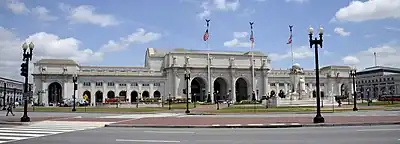
Just like in Europe, the rail companies of the 19th century built grandiose "bourgeois cathedrals" as a testament to their wealth and the status of rail travel. Later, many cities built "Union Stations" often in even more grandiose fashion to serve as transfer points between trains run by different companies. Perhaps the newest of the grand old stations is Los Angeles Union Station, built in the 1930s in California's Mission Revival style, though other notable old stations still operate in Boston, Chicago, New York City, Philadelphia, San Diego, and Washington, D.C..
With the decline of rail travel, many grand stations were abandoned or put to other uses, with some even torn down, the most notable casualties being New York City's original Pennsylvania Station and Chicago's Chicago and North Western Terminal. The grand, ornate railroad stations of old were often replaced by relatively plain, uninspiring buildings that only served the bare minimum of functions, which were derisively referred to as "Am-shacks". However, the worst years seem to be over and many a grand old station has been painstakingly restored and regained train service, with some notable examples of restored stations being those of Cincinnati, Denver, Kansas City, St. Paul, and Seattle. There has even been some construction of spectacular new stations, such as the replacement for the Transbay Terminal in San Francisco. Many cities are also planning on bringing Amtrak back to their historic train stations, but costs are often a concern.
In many cities, many of the train stations also serve as bus stations for various intercity bus lines as well as a hub for the local city buses operated by city or county government. The "bus station" can be a series of bus stops lined up on a street or streets by the train station or in a lot or another building next to the train station with the ticket counters for the bus companies inside the train station or the bus station building next door. A few train stations are also connected to local urban rail but many systems weren't developed with the train station as the central hub and thus access can sometimes be awkward. Notable examples of train stations serving as local urban rail hubs are Denver and Los Angeles Union Station.
Passenger rail companies
This article talks primarily about travel using Amtrak, the United States' primary national passenger railroad company. For more information on traveling on regional (commuter) railroad services, see the "Get around" section of the city or region you wish to visit.
Amtrak, ☏ +1-215-856-7924, toll-free: +1-800-872-7245. (updated Mar 2022) Amtrak is the quasi-state-owned passenger railroad company of the United States, operating services over some 35,000 km (22,000 miles) of track, serving more than 500 communities in 46 American states and the three largest Canadian cities. Trains carry one or more classes of accommodation: coach, business, and sleeper. A seat in coach class is generally competitive with the price of a Greyhound bus ticket, while sleeper accommodation may be competitive with the price of an airline ticket; however, this depends on the route, and in some cases, a coach ticket is more comparable to a plane ticket, while a sleeper costs even more. Most of the information in this article relates to Amtrak.
The Alaska Railroad, ☏ +1-800-544-0552, is a long-distance railroad owned and operated by the state of Alaska for carrying both passengers and cargo entirely within Alaska. The railroad is famous for its summertime passenger services but also plays a vital part in moving Alaska's natural resources to ports in Anchorage, Whittier and Seward as well as fuel and gravel for use in Anchorage. Some of their cargo trains are also connected to the lower 48 states via rail barges between Whittier and Seattle. Passenger trains run from Seward through Anchorage, Talkeetna, and Denali to Fairbanks, with a spur to Whittier. The Hurricane Turn route between Talkeetna and Denali features North America's last remaining "flag stop" train service: a stretch of track along an area inaccessible by road where residents wait by the side of the tracks and "flag" the train to stop, giving it its name. These trains sometimes are moving fairly quickly and there's a procedure to flag it a significant distance before you actually want it to stop. See the web site for more details.
Brightline is a private company that operates a railway service in Florida between Miami and Orlando, via Fort Lauderdale and West Palm Beach.
Throughout the US, many heritage lines have been maintained or rebuilt as privately owned, tourist lines, which occasionally connect to Amtrak or regional systems. Most of these lines use old railroad equipment (such as steam locomotives) which have been refurbished. There are many such lines, but some of the most notably scenic are the Durango & Silver Narrow-Gauge Railroad and Royal Gorge Route Railroad in Colorado, the Grand Canyon Railway in Arizona, the Cumbres & Toltec Scenic Railroad in Chama, New Mexico; the Skunk Train in Northern California, the Cass Scenic Railroad near Marlinton, West Virginia and the Adirondack Railroad in Upstate New York. There is also the international White Pass and Yukon Route that runs between Skagway, Alaska and Carcross, Yukon in Canada, with stops in Northern British Columbia, providing access to a trailhead of the Chilkoot Trail.
Many large American cities have short- to medium-distance commuter rail systems that connect the city centre to nearby suburbs or smaller cities. Per their name, commuter lines generally focus on serving commuters during weekday rush hours, and thus offer their most frequent service during these times. But some also offer evening or weekend service, which can make them a great way to get out of the big city for a day or weekend trip. In the American Northeast, several commuter rail systems converge and are inter-connected; it is possible, for example, to go from Connecticut to Delaware using only commuter lines, although this would take much longer than on Amtrak and involve numerous transfers. See the individual state's or city's Get around section for more information on traveling by commuter rail.
In particular, Albuquerque, Boston, Los Angeles, New York City, New Jersey, Philadelphia, Washington/Baltimore, Chicago and San Francisco/San Jose have well-established commuter rail systems that are expansive, run very frequently, have high ridership and are well-connected to local transit systems and Amtrak. Outside of these areas, commuter rail systems tend to be more limited in scope and service, with cities such as Dallas, Denver, Fort Lauderdale/West Palm Beach, Miami, Minneapolis, Orlando, San Diego, Seattle, and Salt Lake City having constructed new systems only in the 21st century; many of these newer systems operate on only a single route with very limited service outside the weekday rush hours. California has a set of prominent commuter rail systems that serve the state's largest cities; of particular note there is the Amtrak California system, a set of three Amtrak routes (the Capitol Corridor, the Pacific Surfliner, and the San Joaquin; all described in more detail below) and connecting Amtrak Thruway bus service that is subsidized by the state of California and which run more frequently than typical long-distance Amtrak routes.
Planning your trip
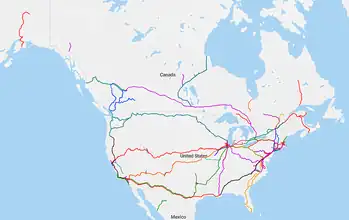
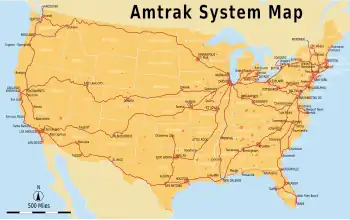

Chicago is Amtrak's main hub for long distance trains, so those who wish to cross the country from the east coast to the west coast by train will most likely have to change trains in Chicago. For instance, someone who wishes to retrace the classic transcontinental railroad journey from San Francisco to New York will need to take the California Zephyr from San Francisco to Chicago, then transfer to the Lake Shore Limited or Cardinal from Chicago to New York.
When to travel
The peak period for most rail companies in North America is somewhere between April to September, and the cost of rail passes and tickets will rise during these periods to reflect this. If you're planning a visit to the U.S. and travel a lot by train, the spring and fall (autumn) periods are likely to give you the best combination of lower ticket prices and hours of daylight for viewing the scenery from the train. Trains fill up much quicker in the summer and around national holidays (especially Thanksgiving weekend), and coach class passengers in particular will have less room to stretch out.
Timetables and brochures
All the major rail operators in the U.S. have websites with information about timetables, routes and on-board facilities. However many passengers still prefer to plan their trips using printed timetables. Amtrak, for instance, publishes a number of brochures, including the Amtrak America travel brochure, but the Amtrak System Timetable (with timetables for every Amtrak train and Thruway bus) can only be found online. However, Amtrak does publish individual timetables for each route.
Read
On-Track-On-Line.com has a number of travel tips for the first-time Amtrak user, as well as an online forum. Seasoned rail travelers can be found online in a number of dedicated rail forums, and are usually more than happy to answer your questions about which route to take. Some other forums worth searching and joining are:
Additionally, the following book goes into much greater detail about the major rail routes of North America:
- USA By Rail by John Pitt, 8th edition, February 2012, Bradt Travel Guides (ISBN 184162389X)
Rail passes
If you are planning more than one journey on an Amtrak train, you may be better off investing in a rail pass, which allows unlimited rail travel within a certain period and area. You should, however, compare the cost of individual tickets when pricing and planning your trip.
- The USA Rail Pass. The amount of travel you can do with this pass is calculated in "segments"- roughly speaking one segment starts when you board a train and ends when you leave it, no matter the distance. If your planned itinerary involves many stops or changes of trains, regular tickets can be better value. There are 15-day (8 segments), 30 -day (12 segments), and 45-day (18 segments) passes ; however, all travel must be completed within one year of purchasing the pass. Restrictions apply.
- The California Rail Pass. This pass offers seven days of travel within any 21-day period on most California trains.
Rail passes are not tickets and you should reserve your ticket (and your seat) as soon as you know which train you will be taking, as the number of seats reserved for rail pass holders is limited.
Tickets
Amtrak tickets can be purchased in person from any staffed Amtrak station, over the phone ☏ +1-800-USA-RAIL (872-7245) in the U.S. and Canada) or on the internet. Tickets can be printed at home, downloaded on to a smart phone, or provided at the desk/kiosk. Passengers who purchase tickets at staffed ticket desks should have a government-issued ID with them on hand but can also request that the tickets be sent to their email address instead. A number of travel agencies that sell Amtrak tickets in other countries are listed on the Amtrak website but these may come at a surcharge.
Tickets for most routes are priced in incremental 'buckets': in other words, as seats on a train sell out, the remaining tickets become more expensive. When buying point-to-point tickets, especially during busy holiday periods, it is important to book in advance. Round-trip (return) tickets are priced by simply adding together the two cheapest available one-way fares.
Discounts
Many passengers are able to receive a discount on the cost of the ticket. Discounts are available on tickets (but not accommodation upgrades) to members of the following organizations:
Discounts are also offered to active members of the military, war veterans, senior citizens, passengers with disabilities and their companions, and students. Students now save 15%, no membership necessary; the former 10% Student Advantage card discount is thus terminated. Students of foreign institutions who do not have a student ID in English (required for the 15% discount) may benefit from an International Student Identity Card (ISIC), which provides for a 10% discount. In all cases, you should provide your membership number, if any, when booking your ticket, and show your membership card or other applicable ID on request on board. To obtain a discount on Amtrak trains, passengers must reserve three days in advance on all trains.
Hot Deals
Amtrak offers heavily discounted coach fares on certain trains on the 'Hot Deals' section of their website. These non-refundable and non-changeable fares are generally available for travel in the next thirty to sixty days on routes that have spare capacity. The page is updated every Friday, and you should check back regularly if you want to snap up a bargain. Long distance coach fares of $70 from Chicago to Seattle (for example) are not uncommon, although they become much less common during the more popular summer months. These fares cannot be upgraded to sleeper accommodation at the time of booking, although you may be able to do so if one is available after you board the train.
Since 2005, Amtrak's offering of many of these heavily discounted coach fares has been limited by language in the legislation which grants Amtrak a yearly subsidy. However, this legislative language does not affect routes that receive a subsidy from individual states. Accordingly, those train routes tend to appear frequently on the 'Hot Deals' page of the website.
Boarding the train
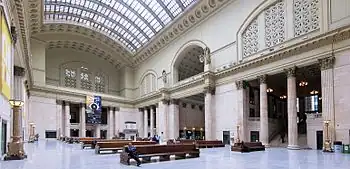
Amtrak tickets generally do not indicate a coach or seat number, merely that you have a place in a reserved coach. Pay close attention to announcements and station staff, who will tell you where to wait and board the train. Attendants will need to see your ticket, ID, and/or pass as you board the train, and they will direct you towards the carriage you should sit in. In some cases, your ticket may show a seat reservation number and a carriage number. If this is the case, the numbers of the carriage are displayed on the doors; pay attention to these as the trains rolls in, so you can be at the right spot on the platform in time to get into your carriage. Some stations have indicators on the platform to show where each carriage will stop.
If you have a specific seat number on your reservation, you are advised to occupy it. Otherwise, follow the directions of the conductor who checks your ticket, and once on board your coach, you may select your own seat. Once you find your seat, you will want to stay there until the conductor comes by to check your ticket after departure. Upon doing so, the conductor will place a seat check (a small piece of paper) above your seat, to indicate that the seat is occupied. Take this with you if you decide to change seats, especially if you are leaving the train en route, because this piece of paper carries a station code to help the conductor let you know when your stop is imminent and shows you have given a ticket to him/her already.
Baggage
Baggage services on long-distance Amtrak trains are comparable to that of air travel, though with far fewer restrictions and little in the way of security checkpoints. Long-distance Amtrak trains will have a dedicated baggage car for checked baggage that you check-in at the station and retrieve at your destination; you are allowed up to four checked bags – the first two free of charge and two more for $20 per bag, each not to exceed 50 lbs. Special items such as bicycles are subject to different restrictions. Passengers are allowed up to two carry-on bags, excepting small items needed for the trip. Passenger cars will have overhead racks or special compartments near the entrance. Detailed baggage policy info can be found here.
Unfortunately, some Amtrak stations do not offer checked baggage as a service, and it would be advisable to check with Amtrak before boarding. A good indicator of whether your stop offers checked bags is to look at the arrival/departure time of your stop. Many stations, such as all of the stations serviced by Amtrak's Capitol Limited and Lake Shore Limited inside the state of Ohio are only accessed by those trains, which arrive in the predawn hours of the morning; as such they are unstaffed, and do not offer checked bags.
On board
The information here relates specifically to services operated by Amtrak. Private train companies and commuter rail services will offer differing standards of on-board facilities. Generally, commuter trains will have unreserved seats and little in the way of amenities aside from restrooms, although some systems might offer services like room for bicycles or quiet cars. Commuter train networks are described under the appropriate regional or city articles.
Amtrak's longer routes feature what are colloquially known as "smoke stops", longer stops where you can go out onto the platform to stretch your legs. They are so-named because smoking is not allowed on board the train, so these stops are where passengers who wish to smoke get off to do so.
Coach class
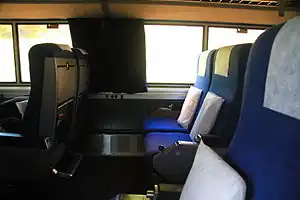
Coach (economy) is Amtrak's most affordable class of travel and is offered on all trains except the high speed Acela trains of the northeast corridor (between Boston, New York City, and Washington, D.C.). A ticket in coach guarantees you a seat in a carriage with 40 to 60 other seats, arranged in pairs either side of the aisle. In almost all cases you will find that seats will all face the direction of travel. Luggage racks and spaces for larger items are provided, along with toilets either at the end of the coach or in the lower level of two-level trains.
Unlike typical intercity trains in, say, Europe, most Amtrak trains don't allow you to reserve a specific seat - a "reserved" seat merely guarantees that a seat will be available somewhere on the train. Groups of 4 facing seats are theoretically reserved for families and groups of three or more. How strictly this is enforced depends on the route and how busy the train is. Staff will normally ensure that children are able to sit next to at least one of their parents or guardians, even if it involves shuffling other passengers around.
An Amtrak coach class seat is roughly comparable with a business class airline seat: there is ample leg room, a reclining seat back and fixed armrests on the outside of each pair of seats. If there is a seat in front of you, a fold-down table will be available. On longer distance routes, there is more legroom as well as a deeper recline and a padded rest that folds up to support your legs when you recline.
Business class
Business class is offered on most trains where there is no first (sleeper) accommodation. There is more room than coach class, with some having at-seat attendant service with complimentary refreshments and a newspaper. On some trains, seats are arranged "2+1" style, in pairs to one side of the aisle, and singly on the other side of the aisle. In other cases seating is similar to coach class, just with a bit more legroom and probably easier access to power sockets. Long-distance trains that travel overnight generally do not offer business class; sleeper class is available instead.
Regular first class
The only first class service offered by Amtrak that does not include a sleeper is found on the Acela trains along the Northeast Corridor. These trains offer only first and business class service. Acela Business Class has 2+2 seating, First Class includes wider, 2+1 seating and complimentary at-seat meals.
First (sleeper) class
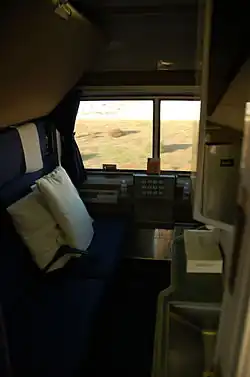
Amtrak markets and prices sleeper accommodation as 'first class', with a level of service that aims to be equal to that of a hotel. In addition to a private room on board the train, first class passengers can take advantage of a number of other amenities, including:
- Pre-departure access to Club Acela and Metropolitan Lounges in Boston South Station, Chicago Union Station, New Orleans, Miami, New York Penn Station, Philadelphia 30th Street Station, Portland, Raleigh, Saint Paul-Minneapolis, and Washington, D.C. Union Station
- All on-board meals included in the cost of your ticket
- An on-board attendant service
- Fresh linen and towel service
- Complimentary bottled water
First class accommodations are priced in addition to the lowest available coach fare, and are priced in incrementally priced 'buckets' according to availability. As each 'bucket' of rooms sells out, the price goes up. For example, if a train has one remaining room available a week prior to departure, it would be priced in the most expensive 'bucket'. On most long distance routes, Amtrak will auction off sleeper rooms 36 hours before departure through its BidUp program, which has a minimum bid of around the lowest fare bucket for the applicable sleeper accommodation. Additionally, after an Amtrak train departs its originating station, if there are any sleeper accommodations still available on the train, they revert in price to the cheapest originally available price.
Amtrak operates two types of sleeper carriage; the precise standard of accommodation that you will have depends on the type of train you will be riding on. Check the timetable or Amtrak website to discover which sort of train you'll be riding on.
Superliner coaches
Superliner two-level coaches are used on all long distance trains west of Chicago, and certain other routes. They offer superior ride quality and better views than single level coaches. Most accommodations are located on the upper level, with toilets and other facilities located on the lower level. Superliner sleeper cars offer the following sleeper accommodations:
- Roomette (for two people, with no en-suite toilet or shower)
- Bedroom (for two people, with an en-suite toilet and shower)
- Bedroom Suite (two bedrooms connected by an opening door)
- Family Bedroom (for two adults and two children, with no en-suite toilet or shower)
- Accessible Bedroom (for two people with an en-suite toilet, but no shower)
While there are no actual limitations, accessible bedrooms should only be booked by those with reduced mobility or a physical disability, and family bedrooms should only be booked by families traveling together. Family bedrooms and accessible bedrooms are on the lower level of the Superliner carriage. Amtrak allows three people to occupy a two-person bedroom, with two sleeping in the lower berth, if reservations are made by phone. Due to space constraints, such an arrangement would be more appropriate for parents traveling with a young child, rather than three adults.
Viewliner coaches
Viewliner single-level coaches are generally used on all long distance trains that operate in and out of New York Penn Station (where Superliner trains are too tall to enter the tunnels that approach the station). They are distinctive because of the two rows of windows on the side of the train, allowing both upper and lower berth passengers a view from their beds. They offer the following sleeper accommodations:
- Roomette (for two people, with an en-suite toilet, but no shower)
- Bedroom (for two people, with an en-suite toilet and shower)
- Bedroom Suite (two bedrooms connected by an opening door)
- Accessible Bedroom (for two people with an en-suite toilet, but no shower)
Accessible bedrooms should only be booked by those with reduced mobility or a physical disability.
Eating and drinking on board
On the shortest of journeys, Amtrak offers an at-seat trolley service of drinks and light refreshments. On most journeys however, there will be a dedicated café or lounge car that offers a marginally broader selection of hot and cold drinks, beer, wine, and spirits, and refreshments, although all snacks will be pre-packed and all hot snacks will be microwaved. Expect to find a very basic selection of sandwiches and snack food items, although a few trains may surprise you with other options (for instance, the cafe cars on many trains sell local wines and craft beers). Café and lounge cars offer an open area of seating around tables that will be open for most of your journey, so even if you don't purchase something from the café you are welcome to sit in the car, enjoy the view and maybe meet some other passengers and on-board staff.
On almost all long distance trains, Amtrak offers a dedicated dining car that will be open for breakfast, lunch and dinner. Meals are generally prepared off the train before departure and then reheated and plated on board. During lunch and dinner service, for example, customers are presented a preprinted menu with a selection of a couple of appetizers, about six entrees, and a few dessert items.
The Amtrak Lead Service Attendant (LSA) who runs the dining car will seat travelers together to fill a table, instead of assigning individuals or couples to a table by themselves (however, the LSA will seat a family together). This practice tends to surprise those unfamiliar with it. In many cases, a traveler will find an interesting conversation happening that would never come about otherwise.
As mentioned above, all meals and one alcoholic beverage during dinner (for the entire journey, not per meal) are included in sleeper tickets. Coach passengers can pay according to the menu except on the Auto Train which offers free meals to all passengers, including Coach passengers. Per meal, the breakfast menu is the cheapest and dinner is the most expensive. Reservations are required for lunch and dinner; after boarding the LSA will travel through the train taking reservations. Reservations are handled in time increments, so during meal time the LSA will periodically announce when each group of reservations will be served.
Given the high price of meals from the dining car, many seasoned travelers bring their own snacks with them on the train, and then supplement them with the odd item from the lounge or café car. However, you aren't allowed to consume any food you bring on board in the café car, and federal guidelines prohibit the dining staff from handling any food you bring on board (even if it's just to reheat something in the microwave).
Amtrak trains offer at seat meal and refreshment service for disabled passengers who are unable to access the dining car and the cafe.
With the exception of sleeper passengers who consume them in their own cabins, passengers are not allowed to bring their own alcohol on board any Amtrak train.
Other amenities
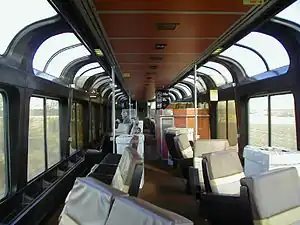
Many of Amtrak's short and mid-range trains as well as some of the busiest stations offer free wi-fi, though this service can be rather unreliable, and blocks some high-bandwidth uses such as video streaming sites.
Most of the long-distance trains west of Chicago include observation cars, also known as lounge cars, with very large windows to view the scenery. They are open to all passengers, whether you have a room or just a coach seat, and the seats and tables are first come, first serve.
Some short and mid-range lines, namely those in the Northeast Corridor, also offer a Quiet Car where cell phone conversations are specifically prohibited and any device that creates noise must be silenced (and you will get dirty looks and be asked to move if you break the rules). This is a relatively new service and is slowly being expanded to other short-distance routes.
Tipping
Travellers are expected to tip their servers in the dining cars, and their sleeper car attendants if they ride in the sleeper cabins. For the dining car servers, a general rule of thumb is 15-20% of the meal cost if you are a coach passenger paying for the meal, or $2-3 per person for breakfast, $3-5 per person for lunch, and $5-10 per person for dinner if you are riding in the sleeper car and your meals are included. For the sleeper car attendant, the generally accepted rate is about $10-20 per person per night. You should therefore ensure that you bring enough small change to cover you for the entire journey.
Private rail cars
Particularly on Amtrak's long distance Western routes, you'll see privately-owned railcars attached to the end of the train with some frequency. Prior to the advent of the private jet, these were the last word in luxury travel in America, and a number of wealthy individuals still own private cars, some of which can be rented through a number of different websites.
This is still a very expensive way to travel, as you must pay not only to rent the car but also for Amtrak to haul it around, and for any switching moves. Think of it as the equivalent of luxury trains overseas, such as the Orient Express revival service in Europe, South Africa's Blue Train or India's Maharaja Express. If you have a large enough group, the per-person cost can approach affordability, though it will still be a multiple of a sleeper berth on Amtrak. See the Amtrak web page linked above for information on how to arrange a trip via private car, and links to several brokers.
Delays
Unfortunately, delays are common on long-distance Amtrak routes. This is because private railroads own most of the tracks used by Amtrak, and they are more concerned about their own freight trains than about Amtrak's passenger trains. Average delays vary considerably among routes. In the last decade Amtrak has increased its effort to ensure trains are on time, and most trains arrive on time well over 50% of the time. Some states (most notably California, where three of the six most popular Amtrak routes run) have taken steps to ensure higher punctuality by giving Amtrak priority over freight or investing in infrastructure themselves. The Amtrak Status Maps Archive Database provides a wealth of information on Amtrak punctuality, and checking it is well worth your time if you want to see how likely you are to make a connection or arrive by a certain time.
Routes
Amtrak has over 30 passenger train services. There is a high concentration of routes in the Northeast and Midwest, with a lot of interconnecting lines and routes are more likely to run multiple times a day. In the South or the West (save for a small concentration of lines in California), services dwindle dramatically with only a few lines and a small number of connecting points, however these lines are also among the most scenic in the country.
- The Acela takes you from Boston, Massachusetts to Washington, D.C. via New York City, Philadelphia, and Baltimore. It also stops in Providence and New Haven, providing easy access to Brown and Yale Universities. This is the only route in the country which resembles a high-speed rail line, with a top speed of 150 mph (241 km/h), though it can only go this fast on a few short segments. There are multiple daily departures and the length of the ride from Boston to D.C. is seven hours. The Acela is pitched mainly toward business travelers, and is fairly expensive by US, and indeed world, standards. The Northeast Regional (described below) serves every station (and more) that the Acela serves, often with little reduction in comfort, hardly any increase in travel time, and is usually much cheaper. On Amtrak's website, entering a city pair and desired travel date will show all available trains between those destinations, so it is easy to compare them.
- The Adirondack travels from New York City to Montreal via Albany and is one of Amtrak's most scenic routes, passing through the Hudson River Valley and the Adirondack Mountains. The autumn colors along this route are renowned and make it a spectacular trip in the fall. The route runs daily and takes 10 hours.
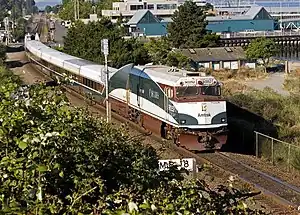
- The Amtrak Cascades takes you from Eugene, Oregon to Vancouver, British Columbia via Portland, Oregon and Seattle, Washington, though no train runs the full Eugene-to-Vancouver route. This route uses a distinctive brown Talgo trainset in lieu of the normal blue livery and passes by some lovely Pacific Northwest scenery, including beautiful coastlines and pine forests. Additionally, the cafe car onboard serves wine and regional cuisine. There are multiple daily trains running over various sections of the route; in total, including the Coast Starlight which runs on the same route between Seattle and Eugene, there are two trains daily between Vancouver and Seattle, seven trains daily between Seattle and Portland, and three trains daily between Portland and Eugene. Vancouver to Seattle takes 4 hours, Seattle to Portland takes 3½ hours, and Portland to Eugene takes 2¾ hours.
- The Amtrak Hartford Line goes from New Haven, Connecticut to Springfield, Massachusetts via Hartford.
- The Auto Train is a unique service designed to carry passengers and their automobiles from the Northeast down to Florida, with cars specifically designed for holding autos. There are only two stops: Lorton, Virginia just outside of Washington, D.C., and Sanford, Florida near Orlando. Service is daily and takes 17½ hours.
- The Berkshire Flyer runs only in the summer, as a pilot through 2026, connecting New York City with the Berkshires in Massachusetts, via upstate New York.
- The Borealis runs daily from Chicago to Minneapolis/Saint Paul via Milwaukee, following the same route as the Empire Builder.
- Amtrak's California Zephyr travels from Chicago, Illinois to Emeryville/San Francisco (San Francisco is a short bus ride from Emeryville) via Omaha, Nebraska; Denver, Colorado; Salt Lake City, Utah; and Reno, Nevada. This is arguably Amtrak's most scenic route, passing through spectacular mountain passes and narrow canyons in the Rocky Mountains and the Sierra Nevada and traversing across expansive plains and deserts. Service is daily and takes 51½ hours to complete.
- The Capitol Corridor is a commuter service from Auburn to San Jose, California via Sacramento, Emeryville, and Oakland (with bus connections to San Francisco). Though a short-distance line, the train does pass by some beautiful Bay Area scenery. There are multiple daily departures and the trip takes 3½ hours.
- The Capitol Limited runs from Chicago to Washington, D.C. via Cleveland, Ohio and Pittsburgh, Pennsylvania. This route follows the historic B&O railroad line, passing through many scenic narrow river valleys and old industrial towns as it crosses the Allegheny Mountains. Service is daily and takes 18 hours to complete.
- The Cardinal connects New York City with Chicago via Washington, D.C., Cincinnati, Ohio, and Indianapolis, Indiana. The route traverses some beautiful Virginia and West Virginia scenery, crossing through the Allegheny and Blue Ridge Mountains, rolling hills and lush river valleys. The train operates three days a week and is a 26½ hour trip.
- The Carolinian travels from New York City to Charlotte, North Carolina; via Philadelphia, Pennsylvania, Washington, D.C., and Raleigh, North Carolina. Service is daily and takes 13½ hours to complete. Complementing the Carolinian in North Carolina is the Piedmont, which makes the 3 hour trip between Raleigh and Charlotte, North Carolina four times daily.
- The City of New Orleans takes you from Chicago, Illinois to New Orleans, Louisiana, via Memphis, Tennessee. The ride is 19 hours long and operates daily.
- The Coast Starlight runs from Los Angeles, California to Seattle, Washington via Santa Barbara, California; San Jose, California; Emeryville, California (a short Amtrak bus ride from San Francisco); Sacramento, California; and Portland, Oregon. Although the moniker is "Coast Starlight", the coast is visible for only a short while between Los Angeles and San Luis Obispo, however the route does also pass through some pine forests with excellent vistas of mountain peaks in Oregon and Washington. Service is daily and takes 35 hours to complete.
- The Crescent runs from New York City to New Orleans, Louisiana; via Philadelphia, Pennsylvania; Washington, D.C.; Charlotte, North Carolina; and Atlanta, Georgia. Service is daily and takes 30 hours to complete.
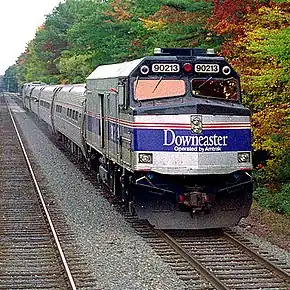
- The Downeaster runs from North Station in Boston, Massachusetts to Portland, Maine before continuing on to Brunswick, Maine. The train passes through some scenic New England mill towns and along beautiful stretches of Maine coastline. It operates 5 daily round trips between Boston and Brunswick. The trip takes 2½ hours Portland to Boston and 3 hr 25 min from Brunswick to Boston.
- The Empire Builder runs from Chicago to either Portland, Oregon; or Seattle, Washington via Milwaukee, Wisconsin, Minneapolis, Minnesota, and Glacier National Park. One of Amtrak's most popular long-distance routes and one of the most scenic, the Empire Builder passes through beautiful wide open plains and spectacular Rocky Mountain vistas, with views of lush pine forests and snow-covered peaks. This route operates daily and is a 46 hour ride.
- The Empire Service is a train running multiple times a day between New York City and Albany, New York, with some trains continuing to Buffalo and Niagara Falls, passing through the Hudson River Valley and the Finger Lakes region. The trip takes 2½ hours to Albany and 9 hours to Niagara.
- The Ethan Allen Express connects New York City to Albany, New York, Rutland, Vermont, and Burlington, Vermont. The route passes through some marvelous upstate scenery and is an excellent option for taking in the fall colors. The service runs daily and takes 7½ hours.
- The Heartland Flyer runs from Oklahoma City, Oklahoma to Fort Worth, Texas, passing through prairie country and along rivers, including the scenic "Big Canyon" area of the Washita River (where bald eagles can be seen during the winter). Service is daily and takes 4½ hours.
- The Hiawatha is Amtrak's shortest line, running from Chicago, Illinois to Milwaukee, Wisconsin in a mere ninety minutes. Multiple daily departures.
- The Illinois Service is a collection of lines radiating out of Chicago, Illinois, crossing the state and terminating in Quincy, Illinois, Carbondale, Illinois, or St. Louis, Missouri. All lines run multiple times a day and the longest line takes 5½ hours.
- The Keystone and the Pennsylvanian connect New York City to Pennsylvania via Philadelphia, with the Keystone terminating in Harrisburg while the Pennsylvanian continues across the Allegheny Mountains to Pittsburgh. The Keystone runs multiple times a day and takes about 4 hours, while the Pennsylvanian runs daily and takes 9½ hours.
- The Lake Shore Limited runs from Chicago to either Boston, Massachusetts or New York City, via Cleveland, Ohio and Buffalo, New York. Runs daily and takes 19½ hours (Chicago-New York) or 22 hours (Chicago-Boston). The run to and from New York City travels along the scenic Hudson River Valley.
- The Lincoln Service runs daily from Chicago to St. Louis, taking about five hours.
- The Maple Leaf connects New York City to Toronto via Niagara Falls and passes through some beautiful upstate scenery. The train runs daily and takes 12½ hours.
- The Michigan Services are a set of train routes radiating out of Chicago, Illinois to Michigan, terminating in Grand Rapids, Port Huron (via Lansing), or Pontiac (via Detroit). The Grand Rapids and Port Huron trains run daily, while the Pontiac via Detroit train runs three times a day. The longest line takes 6½ hours.
- The Missouri River Runner crosses Missouri, linking St. Louis, Jefferson City and Kansas City. Service runs twice daily and takes 5½ hours.
- The Northeast Regional is Amtrak's busiest service, connecting Boston, New York City, Philadelphia, Baltimore and Washington, D.C., and the many towns and cities in-between, with some services also continuing south into Virginia. Smaller stops that might be of interest to tourists include Providence for Brown University, New Haven for Yale University, and Princeton Junction, where you can connect to a shuttle service run by New Jersey Transit to Princeton for Princeton University. This is also Amtrak's most frequent service, with multiple daily departures, and the longest trip takes 12½ hours. The Springfield Shuttle runs from Springfield, Massachusetts, and connects with the Northeast Regional at New Haven.
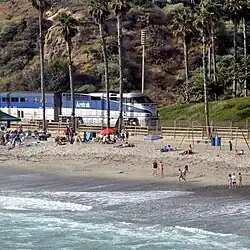
- The Pacific Surfliner runs from San Luis Obispo, California to San Diego, via Los Angeles and Orange County. A perfect way to beat the Southern California traffic and also great for visiting Disneyland, as well as enjoying some gorgeous coastline. The segment through San Clemente is one of the few places in the world where a rail line runs directly next to the beach. There are multiple departures every day and it takes about 6 hours to complete the trip from San Diego to Santa Barbara, with an additional 2 hours to go all the way to San Luis Obispo.
- The Palmetto, Silver Meteor, and Silver Star are three trains which travel from New York City down the East Coast. The Palmetto travels from New York City to Savannah, Georgia; via Charleston, South Carolina. The Silver Meteor travels from New York City to Miami, Florida; via Charleston, Savannah, and Orlando, Florida. The Silver Star follows essentially the same route as the Silver Meteor, except it takes a different route through the Carolinas and makes a detour to Tampa, Florida. All three trains run daily, and the length of the trip is up to 28 hours.
- The San Joaquins connects Sacramento, California and the San Francisco Bay Area with the Central Valley of California, running south to Bakersfield. There are multiple daily departures and the trip takes up to 6 hours.
- The Southwest Chief travels from Chicago, Illinois to Los Angeles, California; via Kansas City, Missouri, Albuquerque, New Mexico and Flagstaff, Arizona. The route is similar to that of the Santa Fe Railway's Super Chief train; it parallels the old Santa Fe Trail between Kansas City and Santa Fe, and Route 66 between Albuquerque and Los Angeles. The route passes through some lovely desert and mountain scenery, cutting through narrow canyons and red rock country. Service on the 40-hour route is daily.
- The Sunset Limited travels from New Orleans, Louisiana to Los Angeles, California via San Antonio, Texas. This route comes within sight of the Mexican border for portions of the route and passes through a lot of desert. Service is three times a week and is 48 hours from start to end.
- The Texas Eagle travels from Chicago, Illinois to San Antonio, Texas; via St. Louis, Missouri, and Dallas, Texas. Service is daily and takes 32½ hours to complete. Three days a week, the train continues to Los Angeles via the Sunset Limited.
- The Valley Flyer runs multiple times per day from New Haven, Connecticut, to Greenfield, Massachusetts, via Hartford and Springfield.
- The Vermonter has daily service from Washington, D.C. to New York City, New Haven, and St. Albans in Vermont. It is a very scenic route with some beautiful views of Vermont. From St. Albans, it is only a short bus ride to Montreal. The trip takes 14 hours to complete.
- The Winter Park Express is targeted toward winter sports enthusiasts and offers service from Denver to Winter Park, Saturdays, Sundays, and select Fridays only, from January thru March. A train leaves Denver in the morning and returns in the evening. The trip takes about 2 hours. This train has a tendency to sell out when skiing conditions are good.
Thruway buses and other connections
Amtrak operates numerous "Thruway" bus services that connect with its trains, providing services to communities with no train service or in some cases filling in "gaps" in its network. These are typically fairly modern, comfortable motorcoaches. For the most part, these can be booked via Amtrak's website as if they were trains - the website makes it clear which part of the journey will be by bus. If a train is late, the bus will be held in order to meet it. As convenient as it might sometimes be, you can't in most cases book a journey that only includes a bus, though if you don't have checked baggage there's nothing stopping you from booking a bus-train journey for one stop down the line past your destination, and just not getting on the train.
Amtrak's service map also shows some ferry services and, in at least one case (the Grand Canyon Railroad), a private rail operator as thruway connections. These are generally not operated by Amtrak, cannot be booked through Amtrak, and will not necessarily wait for a late train.
Non-Amtrak Routes
- The Alaska Railroad also operates some scenic routes during the summer months. "Adventure Class" is the Alaska Railroad's economy class, with some routes having a more expensive "GoldStar Service", which gets you a seat in a glass-domed car that allows you to enjoy the scenery better and includes on-board meals.
- The Denali Star is the Alaska Railroad's flagship route, travelling between the state's largest city Anchorage and the state capital Fairbanks via Denali National Park.
- The Coastal Classic travels along the coast between Anchorage and Seward, and is regarded as one of America's most scenic rail journeys.
See also
- Bus travel in the United States: Outside of the northeastern and Mid Atlantic regions buses reach more places with greater frequencies than trains.
- United States without a car